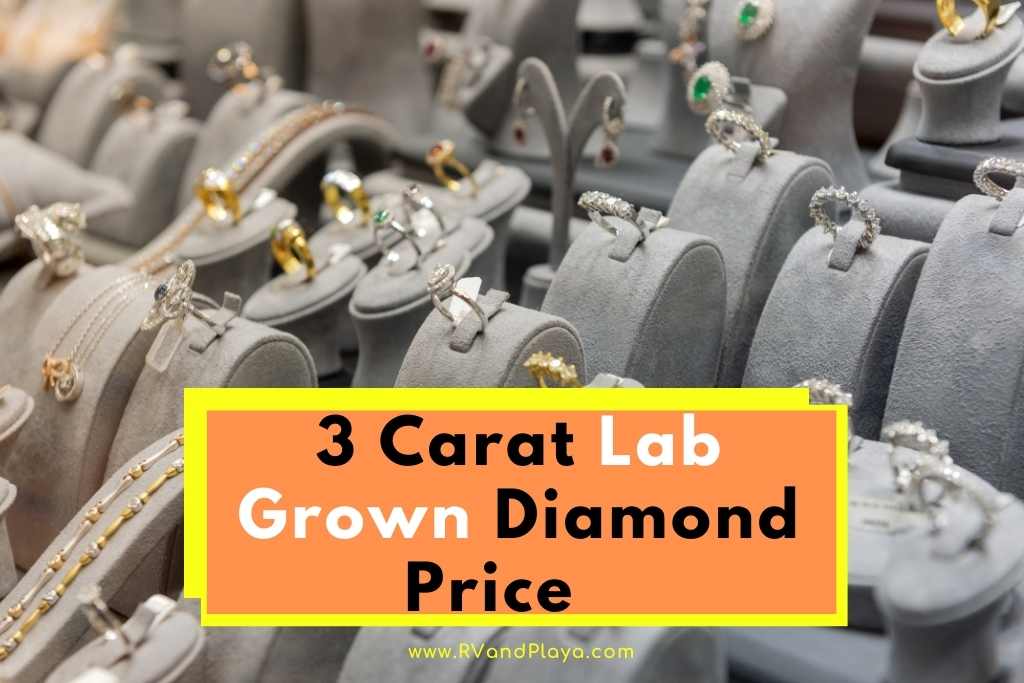It used to be that larger stones–over 2 carats or so–were only for the wealthy. Nowadays, if you want your sweetie (or yourself) to have a giant rock to swoon over, you can get a 3-ct lab-grown stunner for under $10K. Oh, and it looks just like a natural diamond.
You can purchase a good-quality 3-carat lab-grown diamond from a trusted online retailer for as little as $4,000. Many eCommerce sites have a wide variety of 3-carat stones in the $5,000-$9,000 range. A 3-carat, colorless, internally flawless lab stone will run around $30,000, but it’s just about the best stone money can buy (and still cheaper than natural).
If you are in the market for a 3-carat dazzler, read on for all the info on 3-carat lab grown diamond price and whether to buy a lab-diamond at all.
Table of Contents
What is a Lab-Grown Diamond?
Lab diamonds are exactly what they say they are–real diamonds grown in a lab rather than mined from the earth.
There are two ways to make lab diamonds: High Temperature, High Pressure (HPHT), which mimics the way diamonds are formed in nature, and Carbon Vapor Deposition (CVD), in which carbon vapor forms around a seed diamond.
If you buy a lab-grown diamond with a certificate, you will be able to see which method was used to form your diamond, though it doesn’t really matter–both create the same stone.
Both methods form beautiful diamonds in significantly less time than the mining process. In addition, lab-created diamonds don’t cause the environmental destruction of mining operations and aren’t associated with the same human-rights issues as conflict diamonds.
Read also >> What Is A Lab Grown Diamond Called? (All You Need To Know)
Read also >> 2.5 Carat Lab Grown Diamond Price (Current Price)
Is a Lab Diamond Real?
Yes, a lab diamond is completely a real diamond. It looks and behaves exactly like a natural stone. Lab diamonds even tend to have fewer inclusions than real stones, due to the way they are formed.
White lab diamonds are chemically identical to natural diamonds (almost entirely carbon, arranged the same way as a natural stone). You won’t be able to tell the difference.
You can also purchase lab stones in a variety of colors.
Are Lab Diamonds Graded?
Yes–since lab diamonds are identical to natural diamonds, they are graded by the same labs as natural stones, using the same criteria.
The only difference is that the lab will identify the stone as lab-created, and the process used, on the certificate.
Lab stones are graded by the big labs: Gemological Institute of America, American Gem Society, and International Geological Institute.
These are highly respected gem-grading labs and can also be trusted with lab diamonds.
- Save an Average of $350* on Lab-Created Diamonds
- James Allen is the leader in online diamond sales
How Are Lab Diamonds Graded?
Like natural diamonds, they are graded using the 4Cs: Cut, color, clarity and carat. Lab diamonds are not all colorless or flawless–they still can have traces of color or inclusions from the growing process.
Cuts vary from Super Ideal all the way down to good. You will of course pay more for super ideal or true hearts cuts.
Color ranges for sale are D-J. D stones are the most colorless, while J is considered near-colorless, but may have some color visible to the naked eye. Color is often a matter of preference. The differences between color grades are very small, though you will pay much more for a colorless stone.
Clarity ranges from IF (flawless) to SI2 (slightly included). Slightly included stones may have inclusions that can be seen with the naked eye.
All the online sellers now provide high-resolution images of their stones, so you can see up close how the cut looks and whether there are any visible inclusions.
Are Lab Grown Diamonds Cheaper?
Lab diamonds are significantly cheaper than natural stones, by some estimates they are around 40% cheaper. See below for a chart of the price of 3-carat round stones you can buy at the leading online diamond retailers.
The least expensive stones are at the top. Keep in mind you will pay less for something just under 3-carats, and no one will be able to tell the difference.
On the VRAI website, all the diamonds were under $6,500. Other sites had more variety, with some colorless (D-E) or eye-clean stones selling for over $10,000.
All the stones on Clean Origin were graded excellent cut and ranged from $3,700 to $9,000.
The most expensive diamond was a D color (colorless), internally flawless, 3.05-carat for $30,920. By comparison, the cheapest natural diamond in the 3-carat range on Jamesallen.com was $31,400.
You can see here how cut and color make a large difference in price.
| CARAT | CUT | COLOR | CLARITY | PRICE | SITE |
|---|---|---|---|---|---|
| 3.10 | Ideal-Hearts | J; near colorless | SI1; slightly included | $4,893 | vrai.com |
| 3.01 | Excellent | G; near colorless | SI1; slightly included | $4,939 | cleanorigin.com |
| 2.91 | Ideal | J; near colorless | VS2; very slightly included | $5,580 | brilliantearth.com |
| 3.02 | Excellent | E; colorless | SI1; slightly included | $5,710 | cleanorigin.com |
| 2.96 | Very Good | I; near colorless | VS1; very slightly included | $6,710 | Jamesallen.com |
| 3.02 | True Hearts Ideal | I; near colorless | SI1; slightly included | $7,800 | Jamesallen.com |
| 3.05 | Excellent | E; colorless | VVS1; very very slightly included | $8,965 | cleanorigin.com |
| 3.01 | Ideal | E; colorless | VS2; very slightly included | $13,620 | brilliantearth.com |
| 3.09 | True Hearts | D; Colorless | VVS2; very very slightly included | $24,790 | jamesallen.com |
Can A Jeweler Tell if a Diamond is Lab Created?
Not without special equipment. A gem lab can tell if a stone is natural or lab-created, but most jewelers probably cannot.
A jeweler will be able to spot a real vs. imitation diamond based on the way light refracts in the stone and other considerations, but a jeweler cannot tell the difference between a lab diamond and a natural diamond, even with a microscope.
That said, lab diamonds are inscribed with serial numbers that identify them as lab-created.
Does Lab Grown Diamond Have Value?
It is impossible to know what the resale value of lab-grown diamonds will be. Some predict that their resale value will fall when there is too much supply (they only take three months or so to grow, so they are easy to make).
It is also possible that the prices of all diamonds will fall when lab-diamonds become popular.
Others believe that lab-grown diamonds will retain a portion of their sale price, just like natural diamonds.
Prices of natural diamonds fluctuate, and it is impossible to predict the resale price of natural stones as well. Resale value of natural stones is often not very good.
Does Lab Grown Diamond Last?
Lab-grown diamonds last just as long as natural diamonds. Contrary to popular belief, no diamonds last forever. Eventually, they all turn to graphite, but don’t worry–it takes a really really long time.
Are Lab Diamonds Better than Natural Diamonds?
This is a matter of personal preference. Some people love saving money on a stone that looks exactly the same as a natural diamond. Others like that they can buy a much bigger stone than they would otherwise be able to.
Still, others prefer lab diamonds because they are concerned about the environmental and ethical impacts of diamond mining. The CVD process actually removes carbon vapor from the environment, turning it into a diamond.
Others prefer only natural diamonds because they like the idea of buying something that was formed millions of years ago and that is a natural product made by the earth.
It is completely up to you. Luckily you can still purchase both types of diamonds in a huge range of shapes, sizes, and quality.
Where Do I Buy a Lab Diamond?
Online sellers like James Allen, Brilliant Earth, Clean Origin, and VRAI are excellent places to buy lab diamonds for cheaper than brick and mortar retailers.
Many happy customers attest to these companies’ service and quality.
You can also buy lab diamonds at retail jewelers like Zales, Kay, and Jared. Or ask your independent jeweler if they have access to loose lab stones.
What is the average cost per carat of lab-grown diamonds?
On average, lab stones cost around $800-$1,000 per carat, though larger stones cost more because they take longer to make. Diamond prices also vary greatly depending on cut, color, and clarity.
James Allen is the leader in online diamond sales. Their imaging technology is the same as inspecting a diamond with a jeweler's loupe. They have the largest exclusive loose diamond inventory online and fantastic prices.
They also have the nicest collection of lab created diamonds online. Save 10% off select lab grown diamonds and 25% off ring settings during limited time sale!
WHAT WE LOVE ABOUT THEM:
- No questions asked returns within 30 days of shipment. James Allen will send you a paid shipping label to return the ring.
- Lifetime Warranty
- Free International Shipping
- Free prong tightening, repolishing, rhodium plating and cleaning every 6 months
- Provide insurance appraisals
- One free resizing within 60 days of purchase
- Free ring inscriptions
- Best-in-class high quality imagery of all diamonds in stock
- 24/7 Customer Service
- Best-in-class packaging
Conclusion
A 3-carat lab stone will run you between around $4,000 and $30,000, depending on the quality of the stone’s cut, color, and clarity.
Many stones are available in the 3-carat range for under $10,000, with good-quality cuts and near-colorless color.
By comparison, natural diamonds in the 3-carat range start at $30,000 and go up from there.
References
https://www.jamesallen.com/loose-diamonds/
https://www.cleanorigin.com/diamonds/
Recent Posts
Shopping for diamonds is a tricky business and trying to find something of significant size can become almost impossibly expensive. If you want to find some more affordable options, then you will...
When you're shopping for diamonds on a budget, you may be looking at lab created diamonds as a more affordable option than their naturally formed options. But with all the man-made options out...


